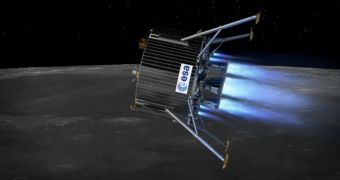At a special facility operated by aerospace company Astrium in Lampoldshausen, Germany, engineers recently tested a series of advanced thrusters, which were developed in order to power up the next European spacecraft bound for the Moon.
The European Space Agency's (ESA) Lunar Lander will be an unmanned spacecraft that will land at the lunar south pole, amid craters which researchers believe are filled with water-ice. The vehicle will be a part of the MoonNext mission.
It will be launched aboard an Ariane 5 delivery system, which will be outfitted with a Soyuz module. Its primary mission is to test an Autonomous Soft Precision Landing (ASPL) system, a capability that will be absolutely essential for landing a spacecraft on the rugged terrain.
MoonNext is scheduled to launch sometime between 2015 and 2018. At this point, experts are putting several of its components together, including the thrusters. These are arguably the most important components, since they will be responsible for decelerating the spacecraft on final approach.
The foundation for the new motors is the thruster currently being used aboard the ESA Automated Transfer Vehicle (ATV) unmanned cargo capsule. However, unlike the ATV, the Lunar Lander will rely on its own thrusters in a rather unconventional way.
One of the main reasons why experts need to perform unusual maneuvers using these thrusters is because the Moon is surrounded by an exosphere that is insufficiently-dense to enable the use of parachutes. As such, spacecraft need to slow their descent using other means.
Astrium, the company tapped by ESA to develop the thrusters, recently completed a prototype, and put it on test at its facility in Germany. The entire motor was tested in a chamber that reproduced conditions on the surface of the Moon precisely.
“The thruster operations were smooth and stable, with great performance, even under the stress of Lunar Lander’s operating conditions,” ESA investigator Bérengère Houdou explains.
But landing on the Moon is not simple. ESA cannot rely exclusively on advanced motors to ensure mission success. Rather, the spacecraft will have to feature a system capable of imaging the lunar surface at brief intervals, and a computer to process the data.
Additionally, a series of laser systems should ensure accurate ranging and distance measurements.

 14 DAY TRIAL //
14 DAY TRIAL //